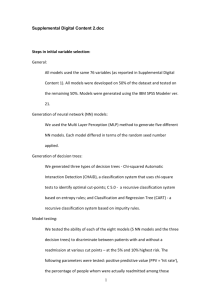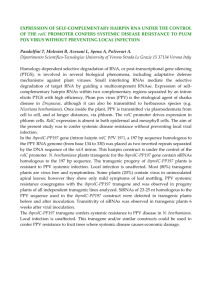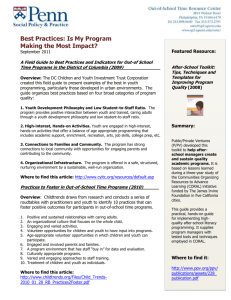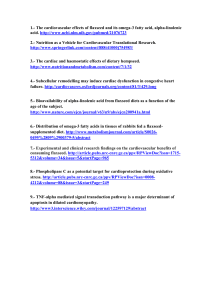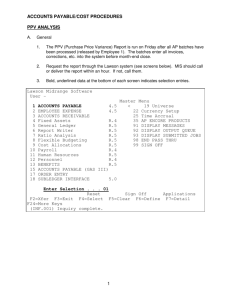Contributor: Patrick L. Carr - The ScholarShip at ECU
advertisement
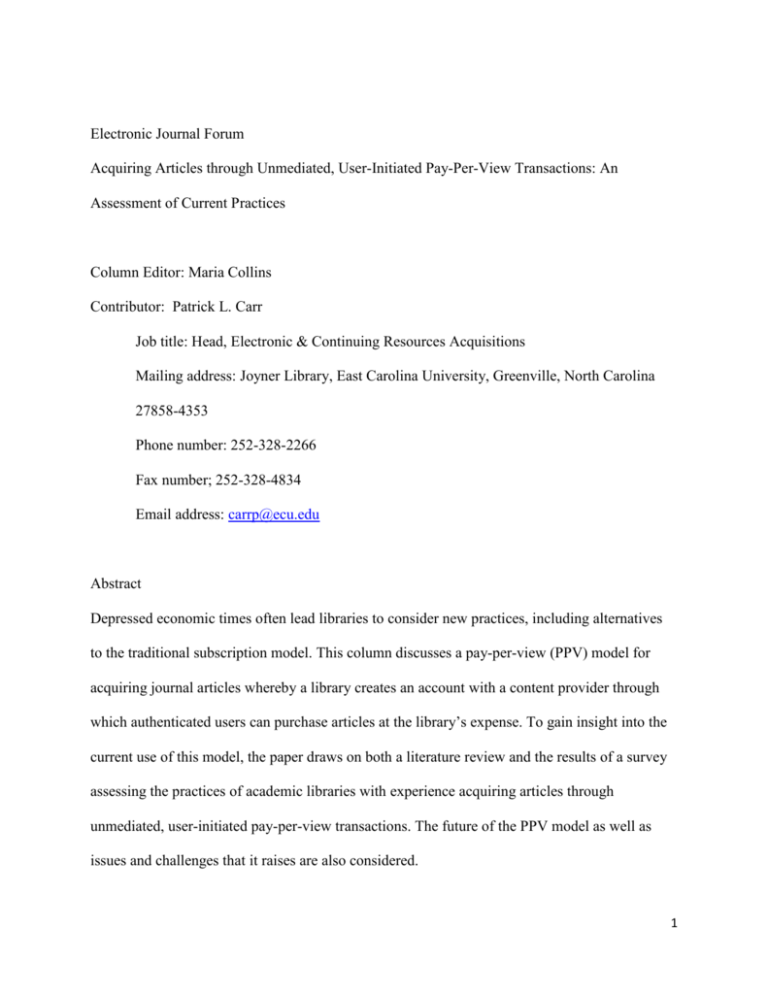
Electronic Journal Forum Acquiring Articles through Unmediated, User-Initiated Pay-Per-View Transactions: An Assessment of Current Practices Column Editor: Maria Collins Contributor: Patrick L. Carr Job title: Head, Electronic & Continuing Resources Acquisitions Mailing address: Joyner Library, East Carolina University, Greenville, North Carolina 27858-4353 Phone number: 252-328-2266 Fax number; 252-328-4834 Email address: carrp@ecu.edu Abstract Depressed economic times often lead libraries to consider new practices, including alternatives to the traditional subscription model. This column discusses a pay-per-view (PPV) model for acquiring journal articles whereby a library creates an account with a content provider through which authenticated users can purchase articles at the library’s expense. To gain insight into the current use of this model, the paper draws on both a literature review and the results of a survey assessing the practices of academic libraries with experience acquiring articles through unmediated, user-initiated pay-per-view transactions. The future of the PPV model as well as issues and challenges that it raises are also considered. 1 Introduction The transition of libraries from print to electronic collections is eliminating many of the restrictions that once shaped the acquisition of journal articles. In a print environment, the only choice libraries generally had for providing ready access to articles was subscriptions to individual journals. The electronic format has introduced new opportunities for acquiring articles that go beyond such traditional containers as issues, volumes, and individual titles. The primary way in which publishers have taken advantage of this new freedom is the aggregation of their journals into packages. In its most complete form, this model, often referred to as the “big deal,” entails that a publisher provides access to its full collection of journals at a subscription cost slightly greater than the total cost of a library’s individual subscriptions. As Hahn showed in a 2005 survey, this acquisition model has been widely adopted by research libraries across the United States.1 But the aggregation of journals into packages is not the only way to take advantage of the new opportunities that the electronic environment offers for acquiring articles. Another, less beaten path is the acquisition of articles through pay-per-view (PPV) transactions. Here, a library subscribes to neither journals nor packages. Instead, the library acquires individual articles that users request. Speaking broadly, PPV can therefore refer to any purchase of an article from a content provider (e.g., a publisher or document delivery service) regardless of whether the one making the purchase is a user or library employee. The focus of this column is libraries’ practices for acquiring articles through one type of PPV: an arrangement in which a library 2 creates an account with a content provider through which users can initiate the purchase of articles at the library’s expense. Following a review of the professional literature, the column describes the results of a survey in which information professionals working at institutions that have implemented or are in the process of implementing the above-described PPV model share their experiences. The column concludes with a consideration of the future of the model as well as issues and challenges that it raises. Literature Review In recent years, the literature’s most thorough discussion of PPV is provided in Business Models for Journal Content, a 2005 report commission by the United Kingdom’s Joint Information Systems Committee’s Journals Working Group (JWG) and undertaken by Rightscom.2 Drawing on the results of interviews with librarians and publishers, the report discusses six potential alternatives to the “big deal” model. Although the interviews show that both librarians and publishers were concerned with the unpredictability and administrative difficulties of PPV, three of the report’s proposed alternatives incorporate PPV access. The report characterizes the first of these alternatives, “PPV Converting to Subscription,” as a model in which a library “may have subscriptions to a publisher’s titles but uses pay-per-view to access other titles on an ad-hoc basis. Usage is based on a per-download cost with a threshold at which sufficient usage has been made to convert to a subscription.”3 The second alternative, “PPV Pre-Purchase,” is geared toward smaller libraries and consists in publishers enabling libraries “to buy blocks of discounted PDF downloads.”4 In the third alternative, “Core + Peripheral,” a “publisher offers a set of ‘Collections’ which may be all their titles in a specific discipline, or even their current 3 subscriptions. Access is then provided to non-subscribed material (the rest of their titles) on a pay-per-view or download cost basis.”5 According to Harwood and Prior, the JWG determined that two of these models, “PPV Converting to Subscription” and “Core + Peripheral,” warranted further investigation by applying the models on a trial basis.6 With the participation of ten UK libraries and five publishers, these trials occurred in 2006. Although practical considerations required some changes from the specifications in the Rightscom report, Harwood and Prior indicate that the trials revealed valuable insights. Among these insights was that PPV increases a library’s administrative burden. The authors state that: Under usage-based pricing models as tested in the trials, libraries would be faced with more administration, which would be essential as opposed to ‘nice to have’, given the financial issues at stake. Usage would need to be scrutinized more regularly, annual budgeting would be more time-consuming and less predictable and there would be an increase in the number of publishers’ invoices to process.7 Another concern that emerged from the trials was that PPV introduces more budgetary uncertainty and risk than the “big deal” model. Harwood and Prior report that, with PPV, libraries face the peril of significant increases in annual expenditures when compared with the cost of providing article access through more conventional means. As a result of these findings, the authors conclude that “the Big Deal, with all its inherent frustrations, is likely to be around for several more years yet.”8 4 Other contributions to the literature also draw attention to problems associated with PPV. Kohl, for example, highlights the model’s dangers.9 Among these dangers are that PPV does not allow for multiple uses of content and that PPV diminishes the role of librarians, reducing them from information professionals to functionaries responsible for “monitoring use and rationing access.”10 Foremost among Kohl’s arguments against PPV is that the model introduces cost considerations into the use of library resources. The author asserts that, while a subscription allows researchers to access articles without limit or hesitations related to cost, PPV not only injects these concerns, but it decreases a library’s promotion of its resources because of the fact that, each time an article is accessed through PPV, the library is charged a fee. A related concern is raised by Golderman and Connolly.11 Whereas Kohl’s misgivings highlight the constraints on access that PPV introduces, Golderman and Connelly suggest a problem created by the model’s lack of constraint. They point to “a scenario in which a patron—out of laziness, ignorance, habit, or desperation—chooses to purchase articles that are readily available within the library’s print collection or possibly even online when that user is properly logged into the library’s portal.”12 Despite the concerns that have been raised about PPV, the literature contains two recent accounts of libraries that have had positive experiences with PPV. Chamberlain and MacAlpine, for example, describe the implementation of PPV at Trinity University (TU).13 They report that in 2007 TU decided to cancel all of its subscriptions to Elsevier journals and instead set up a PPV 5 account. The account gives faculty members unmediated access to Elsevier journals and students receive access to Elsevier journals pending the approval of a librarian or faculty member. In their conclusion, the authors state that, while it is too soon to make a full assessment, so far PPV has proven effective. The survey results below will provide more details on TU’s implementation of PPV as well as an update on the library’s degree of satisfaction with the model. In a 2007 presentation reported on by Wolverton, Bucknall provides another example of the effective implementation of PPV.14 In the presentation, Bucknall described and compared various acquisition models—including individual subscriptions, PPV, and publisher packages acquired through consortial arrangements—that the University of North Carolina at Greensboro (UNCG) has implemented. Bucknall said that in 2002 UNCG cancelled about one hundred journal subscriptions and used a portion of the savings to establish PPV accounts. Over the next three years, PPV increased access while costing far less than what it would have cost to subscribe to the journals accessed through PPV. Although Bucknall ultimately found that consortial partnerships for e-journal packages offer the most expansive access at the lowest cost, he also presented PPV as an effective means for libraries to reduce journal expenditures. The survey results below provide more detailed and updated information on UNCG’s implementation of PPV. A Survey of Current Practices To gain further insights into libraries’ experiences with PPV, the author consulted six information professionals working at libraries from the following universities that have 6 implemented or soon will be implementing accounts with PPV content providers: Murray State University (MSU), Trinity College (TC), Trinity University (TU), University of North Carolina at Greensboro (UNCG), University of Notre Dame (UND), and University of Texas at Austin (UTA). General information about these individuals and their libraries is provided in Table 1. Each participant completed an eleven question online survey in April 2009, and, following the survey, the author contacted the participants through e-mail messages and/or telephone calls with follow-up questions. The following section presents information that the participants shared. Because two of the participants work in libraries whose implementations of PPV access have already been described in the professional literature, the following section also incorporates information from these articles. All information from articles is cited as such; all other information in the section comes from the results of the survey and follow-up communications. [Insert Table 1. Overview of the Libraries Surveyed] The Decision to Establish a PPV Account The participants cited two main factors in their libraries’ decisions to implement PPV: reducing costs and expanding access. For example, MSU and TC both decided to implement PPV due to a combination of cuts in their budgets and increases in the costs of subscriptions. Indeed, TC’s implementation of PPV through ScienceDirect coincided with the cancellation of certain Elsevier journals, and, as the library’s use of the model has expanded, additional Elsevier journals have been cancelled. Likewise, TU found that it could not maintain its Elsevier subscriptions without significant cancellations of other subscribed resources. Its response was to cancel all of its subscriptions to Elsevier journals in 2007 and then use some of the funds that would have been 7 applied to these subscriptions to establish a ScienceDirect PPV account. With the account, faculty members were given the ability to download articles from Elsevier journals, with the library paying the $30 transaction fee. As Wolverton indicates in his report on a presentation by Bucknall, UNCG’s experimentation with PPV began in 2002, when the library was forced to make significant cuts in its serials budget.15 The library ultimately achieved reductions exceeding its target, a fact that enabled it to establish PPV accounts with a number of content providers through which cancelled journals remained accessible. Although UNCG now provides access to content from most larger publishers through packages, it continues to use PPV for articles published in journals from smaller publishers that are occasionally accessed by researchers but not heavily accessed. For such articles, PPV provides a lower cost per use than a subscription. The cost effectiveness and the extent to which PPV broadens researchers’ online access were also central in the decisions of UND and UTA to provide PPV access. At UTA, the decision to implement PPV did not coincide with subscription cancelations but rather the services were implemented as a way to enhance services to users. While UND’s implementation of PPV via Infotrieve did follow shortly after the cancellation of a journal package from Springer, the availability of PPV was not a factor in the decision to cancel the package. Instead, the use of Infotrieve for PPV was identified after the cancellation as a way to both expand access and console faculty members for the loss of access to journals in the Springer package. During and after the period in which PPV was being assessed for implementation, the libraries generally communicated with relevant portions of their user communities to gain support and educate users. At MSU, where a PPV account with ScienceDirect is being implemented, the 8 library is developing a proposal and marketing campaign for the university’s faculty members and administrators. At TU, Chamberlain and MacAlpine state that, prior to the implementation of PPV for Elsevier content, the library formed a focus group consisting of one faculty member from each of the seven departments most impacted by the decision to cancel Elsevier subscriptions.16 To persuade the group’s members to embrace PPV, TU librarians provided them with a trial version of the PPV access that was to be implemented and emphasized the savings the library would achieve as well as the expanded access that faculty members would enjoy. TC and UNCG also held meetings with faculty members prior to implementing PPV. At TC these meetings began with the chairs of TC’s science departments and expanded to include discussions with full departments. At UNCG, PPV access was addressed at meetings that were more broadly focused on the need for reductions in journal expenditures. The Implementation of PPV An initial step in implementing PPV is determining what categories of users will be authorized to use the service. The implementations at UNCG, UND, and UTA allowed all affiliated users to access articles through PPV. In contrast, TC currently restricts PPV privileges to faculty members, but in the future the library may broaden access so that students will be able to use the service pending a librarian’s approval. MSU’s upcoming implementation of PPV will likewise restrict access to faculty members with only limited PPV access for students. Finally, at TU, faculty members are free to use the library’s PPV service without restrictions, and students may use the service if they first get approval from a librarian or faculty member; despite the restrictions on students’ access to PPV, TU does promote PPV access to students during library instruction sessions. 9 A second component to implementing PPV is determining the point(s) on a library’s Web presence from which users will be able to reach the service. UND decided to enable its link resolver to provide access to PPV content through links from article citations in databases. TU, UNCG, and UTA likewise provide access through their link resolvers but also provide access through other means. At TU, the library decided to give users additional access to the service by including all ScienceDirect e-journals on its e-journal portal (also known as an A-to-Z e-journal list). Similarly, UTA and UNCG provide access to PPV content through their e-journal portals and also make titles with PPV content available through links in their online catalogs. TC and MSU take a different approach to providing PPV access. At TC, a librarian notifies faculty members of the service and then, upon request, furnishes a department with the login credentials through which PPV transactions can be carried out. The library does not provide links to PPV content through its link resolver, e-journal portal, or online catalog. MSU’s planned implementation of PPV will provide access to the service in a similar way. The library plans to add a link to its home page that will take the user to an intermediate page that describes the nature of the library’s PPV access and provides a link to ScienceDirect. In its initial implementation, MSU plans to give each academic department log-in credentials to be distributed to faculty members within the department. At a later point, the library may broaden access by switching from username/password authentication to IP authentication. Like MSU, most of the other participants’ libraries have a mechanism to inform users of the nature of the transaction that they can initiate. At TU, any PPV transaction is preceded by a page 10 that identifies other ways in which the article may be accessible, including within the library’s print collection and via interlibrary loan. Furthermore, the page lists the cost of the PPV transaction that the library is absorbing. UNCG also provides users with a message informing them of the cost of the content being downloaded and requesting that the service be used responsibly. At UND, a statement is included on its link resolver menu indicating the availability of PPV access through Infotrieve. After clicking the link to proceed with a transaction, the user is taken to a registration page on the Infotrieve Web site with additional information that UND created to inform users about the nature of the transaction that will be initiated. In contrast to the other libraries, UTA, which implemented PPV through Ingenta in 2007-2008, attempted to eliminate information that would indicate to users the nature and financial details of PPV transactions. The library wanted to increase the seamlessness of the access and eliminate financial considerations that might hinder users from completing the transaction due either to a misconception that they themselves would be charged a fee or because of a belief that their needs for the content were not worth the cost. Unfortunately, Ingenta was never able to successfully remove financial details from its interface. The Impact of PPV The impact of PPV on the participants’ workflows for administering e-journal access did not prove to be problematic. The participants generally report that the amount of work involved in managing PPV is comparable to the work involved with managing subscriptions. The one added task that a number of the participants highlight as having a noticeable impact is the need to more closely monitor use statistics. They indicated that this is necessary for a number of reasons, including: 11 Ensuring that the service is not being misused; Determining if an account balance is low and needs an additional deposit; and Identifying journals that receive a high enough level of use that it would be more cost effective to subscribe than provide PPV access. Some of the participants cite aspects of managing PPV that are actually less labor-intensive than managing subscriptions. For example, TC reports that, because of its deposit account with its PPV content provider, invoicing has become less burdensome. Likewise, UNCG reports that PPV has provided respite from some of the more burdensome aspects of subscription management, including managing issues related to “big deals” (e.g., titles transferring between publishers), license negotiations, and retaining perpetual ownership of content. Finally, TU reports that managing PPV for access to Elsevier publications has proven far less challenging that managing Elsevier subscriptions. In part, this is due to the fact that the library made a significant prepayment on its deposit account for PPV access, and, since this prepayment, it has simply monitored monthly statements of PPV transactions to which the prepayment has been applied. Overall, most of the participants reported positive experiences with their implementations of PPV. TC and TU both have no plans at this time to revert back to subscriptions to Elsevier journals. They indicated that PPV allowed them to achieve tremendous savings and are currently exploring whether it is possible to implement PPV accounts with other publishers. At UNCG, which uses PPV for journals from small publishers that receive moderate or low use, PPV costs have typically amounted to just 10 percent of what it would have cost to maintain subscriptions 12 to the journals from which articles were downloaded. The library is pleased with the model and plans to continue using it. Two of the participants had more mixed experiences with PPV. UTA reported that its pilot project with PPV access through Ingenta was not successful. The library was unsatisfied with the accuracy and functionality of Ingenta’s administrative module and was likewise unsatisfied with customization options for the interface of Ingenta’s access platform. Moreover, the library had expected a greater number of journals to be accessible through the service and had concerns that the service was allowing users to initiate PPV transactions for content that was already owned by the library. Because of problems such as these, UTA does not feel that PPV has evolved to the point at which it can cancel subscriptions in favor of PPV access. However, the library does plan to continue experimenting with PPV. While it is satisfied with its use of PPV access through ScienceDirect, UND made the decision not to continue using Infotrieve as a PPV content provider. The primary reason for this is that the library recently became a member of RapidILL, which provides a twenty-four hour delivery time for articles at a lower cost than Infotrieve. Moreover, Infotrieve’s online registration form, which a user must complete prior to initiating a PPV transaction, proved to be a point of confusion, with approximately 80 percent of users abandoning the form rather than submitting it. Analysis A comparison of the survey results with the problems summarized in the literature review yields valuable insights about the issues and challenges of implementing a model of unmediated, user- 13 initiated PPV. The literature review indicated that, in the trials of PPV that were conducted by ten UK libraries in 2006, among the most significant problems to emerge were an increase in the administrative burden of libraries and a decrease in control and predictability of material expenditures.17 Neither of these factors were major problems at the survey participants’ libraries. Indeed, the results showed that, in general, administering PPV access was no more onerous than administering subscription access (and in some cases it was less so). Likewise, the participants did not report that PPV introduced a high degree of uncertainty and risk into their budgets for material expenditures. On the contrary, the savings achieved by PPV mollified the challenges of budgeting for expansive access in an environment of decreasing or stagnant funds and increasing costs. While it is difficult to pinpoint the reasons why PPV led to increased administrative burdens and budgetary uncertainties in the UK libraries but not the US libraries at which this paper’s survey participants are employed, it seems likely that, among the factors contributing to the libraries’ differing experiences, was the specific models of PPV that the UK libraries trialed. Described above as “PPV Converting to Subscription” and “Core + Peripheral,” these models involved more variables and complexities that the models of PPV implemented by the US libraries. Another reason behind the differing experiences of the libraries may have been the fact that, whereas the US libraries’ PPV content providers already had experience with the model, the publishers who provided PPV content to the UK libraries did not all have experience with the model and therefore had not established tools and services to alleviate the administrative burden of libraries. 14 Another charge leveled against PPV is that it introduces financial considerations into the use of library resources. As Kohl warns, “The formerly safe harbor of local information use without financial constraint in order to pursue academic goals disappears as does the library’s ability to pursue an agenda of encouraging information use within the safe harbor.”18 Experiences at the participants’ libraries lend credence to this concern. For example, the participants from UTA and UND both felt that users were not completing PPV transactions at their libraries due to misconceptions—fostered by displays on the interface of articles prices alongside shopping cart and credit card icons—that they themselves would be charged a fee. Likewise, there were concerns that users were not completing PPV transactions due to a perception that that their need for content was not important enough to justify its cost. Moreover, in Chamberlain and MacApline’s article about TU’s implementation of PPV, they report that users accessed articles through PPV far less than TU had expected, a fact they speculate may have been due in part to thrifty faculty members who found it difficult to justify a $30 PPV transaction when a desired article might be acquired through another, less (overtly) costly means.19 Also, Wolverton reports that Bucknall found that use of journal content decreased with UNCG’s implementation of PPV.20 Among the possibilities that Bucknall cited for this decrease were those mentioned above: the misimpression among some users that they would be charged for the transaction and the belief among others that their need for content did not justify its cost. Counterbalancing the concern that PPV unduly constrains access is the concern that unmediated PPV will result in users systematically downloading entire journal issues or carrying out numerous transactions for content that is already held by the library. None of the participants, however, considered this behavior to be a significant problem. Although UND did experience a 15 situation during its use of Ingenta as a PPV content provider in which a small number of faculty members were initiating PPV transactions to content that the library already held, this situation was addressed through individual communications with the faculty members. However, since library’s account with Ingenta was terminated shortly after the library became aware of the problem, it is unclear how successful the communications would have been. When the lack of abuse of unmediated PPV is combined with the concerns among the participants that users were not carrying out PPV transactions due to financial considerations, it suggests that, contrary to what many would suppose, policing PPV access to ensure its responsible use is not the greatest challenge when it comes to providing this type of access. Instead, the challenges seems to be providing this access in a way that is seamless and simple and that does not detract from the library’s ability to meet and promote its core mission of serving the information needs it is user community through unrestricted access. PPV in the Emerging Information Landscape The emergence of unmediated PPV as an option for providing access introduces philosophical questions about the future of library acquisitions and collections. Although answers to these questions are outside this paper’s scope, an entry point to at least understanding what some of these questions are is provided by analyzing the theoretical differences between PPV and publishers packages. Such an analysis reveals that PPV takes advantage of the transition from print to e-journals in a way that is both similar to and opposite from acquisitions through publisher packages. Indeed, while PPV and publisher packages both take advantage of the new opportunities that arise for the aggregation and disaggregation of journal content in an electronic environment, they do so in ways that are in opposition. PPV goes to the extreme of 16 disaggregation by reducing the publisher’s content to its smallest unit, the article. As embodied in the “big deal,” publisher packages take the opposite approach, providing access to the publisher’s full collection. With this aggregation of content comes a uniformity of the content, a fact that is conducive to the acquisition of publisher packages on a consortial level. For libraries, consortial partnerships for the acquisition of packages are advantageous because—due to the partner libraries’ pooling of funds, resources, and expertise—they decrease costs and maximize access. When considered within the framework that has been outlined, consortial partnerships bring to light a second form of aggregation. That is to say, consortial acquisitions of “big deal” packages not only constitute an aggregation of content, they also constitute an aggregation of subscribers. In contrast, PPV acquisitions, which (at least at present) are acquired through individual libraries rather than consortia, constitute a disaggregation of both content and subscribers. Libraries today are moving in the direction of disaggregation. Indeed, the current economic recession and the resultant decreases in material budgets are forcing libraries to make significant cancellations. Because of the preponderance of publisher packages and the large portion of expenditures required to maintain access to these packages, many libraries will not be able to make do with cancellations to individual journals but will instead need to discontinue at least some of its packages. The extent to which libraries disaggregate their acquisitions of journal content is yet to be seen. If they disaggregate only to the level of individual journal subscriptions to selected titles within the packages, the outcome for users will be significantly reduced access to e-journal content. However, the full disaggregation of content through the implementation of PPV offers libraries the possibility to maintain a breadth of access that may be comparable to 17 what users enjoyed through publishers packages. Although PPV would not allow for the libraries’ ownership of the content being acquired, it would enable libraries to continue to provide expansive access at a significantly reduced cost. Ultimately, the role of PPV in the emerging information landscape will be shaped by two factors. The first factor is libraries’ interest in adopting the model. PPV represents a major departure from traditional forms of material acquisitions and is in marked contrast to traditional ideals that libraries should strive for ownership of the content it supplies to users. If PPV is to be play a significant role in library acquisitions in the future, librarians will need to accept new conceptions that fully embrace “just in time” access limited to individual users over “just in case” ownership of a collection accessible without limit to a full user community. For research libraries with commitments to collecting and preserving bodies of literature for posterity, PPV may not be deemed as an acceptable form of acquisitions. However, for libraries with a primary focus on providing users with timely and cost-effective access to resources, PPV may emerge as an increasingly appealing alternative to subscriptions. But, of course, libraries are not the only stakeholder that must embrace PPV. Along with libraries, publishers will need to accept the model. At present, few have. Indeed, of the surveyed libraries, the only PPV content provider that was also a publisher was Elsevier. If publishers are to offer PPV accounts at the institutional level, libraries must communicate that they wish to use this model and publishers must come to regard the model as a possible revenue stream. Among the primary factors hindering the latter of these conditions is, of course, the primary factor that makes PPV appealing to libraries: the fact that the cost-per-use of PPV is oftentimes significantly 18 less than it is for a subscription. However, in the current economic environment, PPV may be the only means of access that libraries can afford to certain previously subscribed titles, a fact that may render PPV in a more favorable light to publishers. Moreover, publishers will have to come to terms with the disconnect whereby they happily embrace PPV transactions initiated by individuals as a valued source of revenue but do not embrace such transactions at the institutional level. Is it not possible that, faced with significant budget cuts, university administrators might grasp this disconnect and redirect funds from library subscriptions to stipends that individual faculty members could use to carry out PPV transactions? Of course, such an outcome would not be desired by either libraries or publishers. Staking out the full potential of PPV is an endeavor that will only succeed if libraries and publishers are both willing to work in a partnership that embraces collaboration and experimentation. While PPV may never become an acquisitions model as prevalent as subscriptions, a number of current trends are converging that make it an increasingly appealing option for libraries. Acknowledgements The author wishes to convey his gratitude to the individuals that agreed to be surveyed for this paper: Tim Bucknall, Katy Ginanni, Benjamin Heet, Lindsey Schell, Jennifer Van Sickle, and Ryan Weir. Without their time and generous input, this research would not have been possible. Notes 1. Karla Hahn, “The State of the Large Publisher Bundle: Findings from an ARL Member Survey,” ARL no. 245 (2006): 1-6. 19 2. Rightscom, Business Models for Journal Content: Final Report (London, UK: Rightscom, 1995). 3. ibid., 8-9. 4. ibid., 9. 5. ibid., 9. 6. Paul Harwood and Albert Prior, “Testing Usage-based E-journal Pricing,” Learned Publishing 21, no. 2 (2008): 133-39. 7. ibid., 137. 8. ibid., 139. 9. David F. Kohl, “From the Editor… Dr. Jekyll and Mr. Hyde or How Reasonable Ideas Can Turn Out Badly,” The Journal of Academic Librarianship 32, no. 4 (2006): 347-48. 10. ibid., 348. 11. Gail Golderman and Bruce Connolly, “Pay by the Slice,” Net Connect (Spr 2007): 18-20, 22, 24-26. 12. ibid., 18. 13. Clint Chamberlain and Barbara MacAlpine, “Pay-per-view Article Access: A Viable Replacement for Subscriptions?” Serials 21, no. 1 (2008): 30-34. 14. Robert E. Wolverton Jr. [recorder] and Tim Bucknall [presenter], “Are Consortium ‘Big Deals’ Cost Effective? A Comparison and Analysis of E-journal Access Mechanisms – Workshop Report,” The Serials Librarian 55, no. 3 (2008): 469-77. 15. ibid., 470. 16. Chamberlain and MacAlphine, “Pay-per-view Article Access,” 32. 17. Harwood and Prior, “Testing Usage-based E-journal Pricing.” 20 18. Kohl, “From the Editor,” 348. 19. Chamberlain and MacAlphine, “Pay-per-view Article Access,” 32-33. 20. Wolverton and Bucknall, “Are Consortium ‘Big Deals’ Cost Effective?” 472. 21
